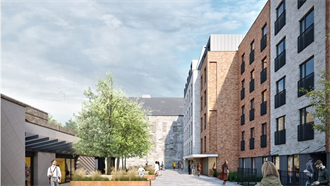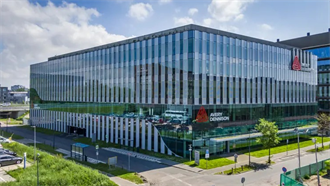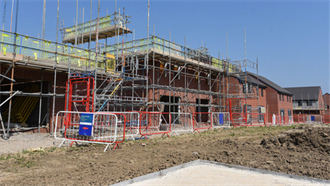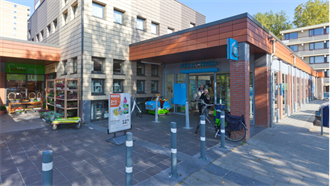Europe craves warehousing and developers are navigating tricky headwinds to provide it. But how high can rents rise – and who pays for the robots?
There seems to be little that can stop the European logistics sector as 2022 approaches. To find out what is going on in this hottest of commercial real estate segments, PropertyEU invited a panel of experts to a special invite-only roundtable event in Utrecht, the Netherlands.
In Q1 of this year the logistics sector defied gloomy conditions caused by Covid-19, to post record deal volumes in Europe’s six leading markets. Fast forward to Q4 and the ongoing loosening of pandemic-related restrictions which throttled business across the continent, meant nobody on the panel expected tenant demand to cool any time soon. Indeed, our panel of experts agreed the logistics sector is a major beneficiary of a confluence of unfolding mega-trends, which the pandemic has only accelerated.
One indicator of the state of play in European logistics was provided by the four professionals on the panel, from the developers Mirastar, Trammell Crow Company (TCC), Prologis and Verdion. Each revealed their firms are on the lookout for talent.
The companies also reported they face headwinds, such as a flood of capital entering the warehouse business, high levels of competition in the investment market, and growing barriers to entry and redevelopment, such as squeezed availability of land in several key markets.
Also still a factor in the segment is the exit of the UK from the European Union, even 18 months after the global health crisis pushed Brexit down the news agenda. The fallout from the EU and UK’s divorce continues to have an effect upon supply chains serving the UK. The panel reported it is fuelling a scramble for space in European locations such as Calais and Dunkirk in France, and Amsterdam in the Netherlands. Meanwhile in the UK, demand for industrial space is red-hot. One common feature of these locations is a serious shortage of available land for development.
Bidding wars
Indeed, at the time our roundtable assembled, there was reportedly a grand total of one building available within the M25 motorway that encircles London. Around 25 occupiers recently bid for the only asset comprising 100,000 m² or more, within the orbital.
‘During the last year, the occupational markets in Europe have been incredible, despite the challenges of the pandemic,’ said Ekaterina Avdonina, CEO and co-founder of Mirastar, a pan-European logistics and industrial platform, which has an AUM and committed pipeline in excess of €1.5 bn.
‘We’ve never seen such a shortage of space in London, or any big city. Ultimately, the yields are a reflection of the occupational markets. Yields in London are under 2% for some deals we’re involved in.
‘Occupationally, we think it’s the strongest market in Europe,’ she continued. ‘We have bidding wars and best bids from occupiers for some of our sites, and this is becoming a new norm.’
In April last year, Mirastar sold half of its business to global investment firm KKR, making it effectively the US company’s platform in Europe.
In parts of the British capital city, rents for distribution centres are currently outpacing Heathrow Airport, historically the most expensive rental location in the country – but no longer, said Ian Worboys, managing director and head of European logistics at Trammell Crow Company.
Also reflecting on the causes and consequences of the skyward trend, James Quill, VP capital deployment, Europe, at US-based giant Prologis, said: ‘There is definitely a need to repatriate a lot of the manufacturing and logistics facilities to the UK and that will obviously demand more logistics space going forwards.’ Prologis has a portfolio of circa €23.3 bn AUM in Europe.
‘The interesting point is the scarcity of land in the core [British] markets,’ he said. ‘There’s almost no new zoning for new development in the M1 corridor between London and Birmingham, which is the area we specialise in.’
The panel reported that the current market is forcing occupiers to take space in areas which may not be their first choice, simply because there is no other alternative. This squeeze is leading to a rise in popularity of low-profile locations that have long been considered tertiary, for example Doncaster. It’s a trend that is observable in several important markets, the panel said.
Challenges in Germany
In Germany, locating quality assets is also difficult, according to Florian Stöbe, head of investment for Germany at logistics real estate specialist Verdion. The firm has a pan-European portfolio of around €1.7 bn AUM. ‘It’s all about finding the right product,’ he said. ‘Not only the right land with zoning, but also existing assets with potential for value-add. We used to focus on the top five to seven locations, but there are no “B” locations anymore.’
Stöbe said he felt positive amid a climate of simultaneously increasing scarcity and demand. ‘We talk about challenges, but I call them opportunities. We believed years ago that logistics was a niche part of the investment sector, but now it is the second-most invested asset class in Europe. There is always somewhere to go.’
The high-profile European market of Germany certainly faces fresh challenges, the panel heard; not least resulting from the deadly flooding that hit western parts of the country, earlier this year. That extraordinary weather event looks set to place more onus upon the environmental, social and governmental (ESG) qualities of assets in future. Then there is political uncertainty about what happens when long-time Chancellor Angela Merkel departs office.
‘It partly depends which parties will be in government in two months’ time,’ Stöbe said, referring to the German elections. ‘However, we’re already focused on sustainable buildings and ESG. The flood crisis is clearly affecting the market – this is especially apparent when we submit building applications and get feedback from authorities. But the industry was already thinking about what this means for future development, and that includes investors.
‘This is not really driven by the government; the industry has been thinking about sustainable buildings for years, although now it is more in focus. In Germany, industry could even act faster than the government by setting new standards ourselves. Climate change is a big topic here so I could see it happening.’
The roundtable agreed that a proactive approach to sustainability is needed as a key part of doing business well, and that failing to keep up with this key trend comes at a cost. Deals have fallen through because they did not meet the requirements of investors seeking sustainable investment products that could then be sold.
Rental growth was an area which the panel of experts were confident about, in the current environment. Everyone noted it is already evident in major markets such as the UK, Germany and the Netherlands. Also a factor is yield compression. Indeed, this question is often front of mind, said Worboys.
TCC recently made its debut UK purchase in Milton Keynes, acquiring a prime site of circa 31,500 m². It plans to speculatively develop three logistics assets there. ‘If you’re buying a site, you know what today’s rents are, but you’re also asking the question: do I believe there’s any future yield compression or perhaps rental growth?’ said Worboys. ‘When it comes to developing somewhere like Milton Keynes, where there is little available new space and therefore little competition that we can see for the next two years, then one may decide to push rents and potential occupiers can choose whether to rent your units or not.’
Rental growth
Rental growth is noticeable elsewhere in Europe. Quill forecast that rents could rise by up to 10% during 2021 in Prague, Czech Republic. Prologis recently withdraw from the market in Austria and Romania. ‘We want to entrench further in the markets we’re already in and try and capitalise on the fundamentals of those markets,’ said Quill.
‘I think rental growth is what we see going forward and cap-rate compression is probably at a trough,’ he remarked. ‘I think that with the EU’s quantitative easing programme and the spread to bond yields, it likely won’t compress much further in the core western European markets, so I think rent growth is what will be pushing investor returns going forward. Our customer-centric approach and programs will allow us to retain our customers more effectively.’
Markets such as Germany and the Netherlands are experiencing much stronger yield compression, the panel noted. In parallel, the German market has witnessed a rise in site pricing during the past 12 months, with prime locations now sometimes reaching up to €500 per m², a level the panel noted would have been almost unimaginable only three or so years ago. Increasing construction costs are also translating into sharp rent increases in some locations.
Conditions such as these were among the reasons why Mirastar and Verdion have been weighing up the possibility of entering the Nordic market.
Robotic future
Automation is another key mega-trend on developers’ minds, as 2022 comes into view. The rise of machines in warehouses is of growing importance for the logistics segment which builds the spaces for tenants, some of whom view this trend is an important part of business planning. Live issues which developers are grappling with include: who pays for the fit-out of a site with robotic tech? Who owns the cutting-edge gear?
The panel noted online shopping behemoth Amazon is pursuing a model of it being landlords who own the equipment, raising pressing questions for developers to do with amortisation and obsolescence.
Worboys was optimistic. He insisted automation has great potential to redound to logistics developers’ benefit. ‘As an ex-landlord, we loved tenants who invested heavily into the mechanism within their warehouse,’ he said. ‘It meant they were “sticky” tenants – the ones who will sign a longer lease and are unlikely to leave. These tenants are less able to move and so face rental growth.’
Amid this shift towards more technology, and as robot armies begin to replace human labour in parts of the economy, the roundtable heard that many fundamentals of big boxes remain unchanged. But what about obsolescence – the shelf life of equipment installed today? One of the issues for investors in automation is that what may be in vogue in late 2021, will almost certainly have turned into a museum piece in just a few years’ time.
Said Avdonina: ‘Sometimes you need to ask the question, what is your depreciation strategy for that automation? Most of the time we’re getting the answer that it’s five years. There’s a belief that a lot of structural change is coming, which is something to keep in mind.’
The panel discussed various approaches for developers in this environment, who may find themselves in the position of bearing the initial cost – and the legacy – of fitting warehouses with high-tech automation equipment, much of it destined for tomorrow’s recycling tips.
Options include the developer paying upfront for the investment and this then being reflected in the rent paid by the tenant, with the amortisation period of the equipment tracking the duration of the occupier’s lease agreement.
At the human level, automation has significant implications, the panel agreed. A study from 2020 by US business consultancy McKinsey was cited, containing the eye-catching claim that robots are on track to replace up to half a billion workers by the end of the decade.
Worboys called automation ‘the biggest change for the future.’ He said: ‘If you go around production facilities in Central, Eastern Europe, you see how automation has changed warehouses. In Slovakia, I visited a facility that assembles tyres onto wheels for Volkswagen and the whole process was automated with huge robots. They are more efficient than humans. Even at the more basic level of distribution, there will be automation, as you won’t need as many people driving forklift trucks because in the future, they will be predominantly automated. In some warehouses automated forklifts are already working, and this is becoming more normal.’
He continued: ‘There’s a social implication to automation that many have not considered. What happens to all the people currently driving forklifts when the driving becomes automated by AI? Could this then happen with delivery drivers etc? Where will people work?’
Sector diversity
But before non-human workers take over factories, there are plenty of professionals working to increase human diversity in the European logistics segment.
Everyone acknowledged the need for more women in the sector. One barrier the panel identified was that the talent pool from which comes the next generation of talent, tends to contain plenty of males, but far fewer females. One outcome of this gender imbalance was the potential for visits to sites to feel like taking a trip in a time machine, back to when workforces were 90% male, or above.
Speaking as the lone woman on the panel of four, Avdonina said change was overdue but was taking place – albeit not rapidly enough. ‘The profile is changing and there’s a lot more women in the industry. I’d like the change to be quicker, but we’re leading with positive examples,’ she said.
‘There’s a community of women in the industrial sector in Europe and we’re doing our utmost to promote the sector and explain to surveyors and students that it’s not intimidating. Walking on to a site where nearly everyone’s male could be intimidating for some, but that just gives you an opportunity to be different and to explain your point of view, which will be very well regarded.’


































